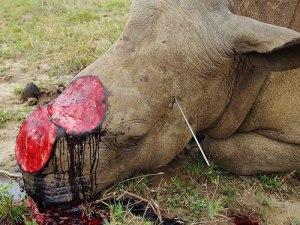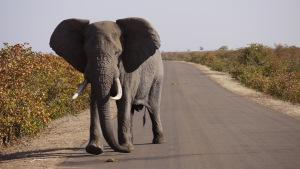 I have the immense honor and pleasure of attending the University of Pretoria’s Mammal Research Institute 50th Anniversary Celebration conference currently being held in the Kruger National Park. To be rubbing shoulders with some of the greats of African ecology is humbling to say the least, but it’s also a huge opportunity to learn about the wonderful wildlife Africa still has.
I have the immense honor and pleasure of attending the University of Pretoria’s Mammal Research Institute 50th Anniversary Celebration conference currently being held in the Kruger National Park. To be rubbing shoulders with some of the greats of African ecology is humbling to say the least, but it’s also a huge opportunity to learn about the wonderful wildlife Africa still has.
Stepping back into what the Pleistocene must have been like in Australia, Europe, and North and South America, I’m moved to near tears by the truly awesome1 megafauna that still exists here. This is my first time to Africa, and I cannot begin to capture how I feel by seeing these amazing species in the flesh.
But as you probably already know, this last megafauna is under huge threat, and we seriously risk repeating the extinctions of the other continents within less than a century. While the topics associated with the threats are diverse, complex and challenging, one talk here stood out for me among all others: that by Ken Maggs of SANParks.
Kruger holds about 70% of the white (Ceratotherium simum) and black (Diceros bicornis) rhino in South Africa, and about 30% all rhino in the world (98.8% of all white rhino are found in just four countries: South Africa, Namibia, Zimbabwe and Kenya).
So for the ~ 10,000 rhino in Kruger, the following numbers should shock you; Ken showed a slide with the following information:
from January to August 2016
- 458 rhino (and 36 elephant Loxodonta africana) have been poached from the Kruger
- 2119 recorded poaching incursions (mean of 9 incursions/day)
- this equates to at least 6357 poachers who have hunted in the park this year to date, or 26 poachers/day on average2

Subject to increasing poaching in Kruger as well (photo by CJA Bradshaw)
Now, Kruger invests hundreds of millions of rand into anti-poaching measures each year, with a literal army of rangers whose sole purpose is to curtail the slaughter. But the arrests and exchanges resulting from this investment are sobering. During the same period this year, there have been:
- only 177 arrests
- 94 firearms seized
- 6 SANParks staff arrested
- 122 ‘physical encounters’ (i.e., shots exchanged) with poachers
Put those numbers into context, with a minimum (remember, these are probably vast underestimates because many poachers go undetected) of 6357 poachers this year to date, and only 177 arrests, the amazing anti-poaching team here is stopping a minimum of < 3% of the poachers. Not good.
Further, this is not just a one off. The following graph (again, from Ken’s data) shows the rhino poaching trend in the Kruger over the last 15 years:

Those numbers are real, and as you can probably sympathise, frightening as hell. While I’ve yet to see a rhino in the park (mainly because they’re mostly in the south away from where I’m staying), I’ll be seeking a sighting in earnest because at these rates, they won’t be around for long.
In fact, Sam Ferreira of SANParks recently estimated that at current rates, the population will likely decline by two-thirds by 2018, which of course means extinction within the next 20-30 years.
I’m really happy that my daughter (who is accompanying me on this trip) will have a good chance to see one. By the time she is my age, they’ll probably be gone. Without major investments in anti-poaching capacity and a global commitment to reduce demand, this bleak future is unfortunately inevitable.
CJA Bradshaw
1I’m using this word correctly here.
2Yes, as I write this, there are 26 poachers (on average) currently hunting in the park.

